If you’re wondering how to make a real umbrella, you’re in the right place, the below guide is all about how Superain makes its umbrellas — from umbrella material preparation to product packaging.
The 11-Step Process
Making an umbrella cost is not high and easy, but that doesn’t guarantee quality. We finish assembling our Superain umbrellas in 11 steps. Undertaking each step ensures stability and performance for your daily use.
Step 1: Providing Samples and Confirming Orders
“What are samples?” you might ask. Simply put, we provide our customers with a sample of their order before we manufacture them.
Providing samples prevents wasteful production costs. If you have a design you want us to use — say, for your company’s promotional umbrellas — feel free to send your requested to us. Afterward, we’ll provide you with a free sample.
Making the sample for a regular umbrella takes more or less five days. For special or custom umbrellas, please wait for about a week.
Once you’ve received it, you can assess its print quality. If you like the sample, we can then move forward to the actual manufacturing of your order. You’ll indicate all the necessary details including your preferred design and the total number of umbrellas.
Step 2: Preparing and Inspecting Umbrella Materials
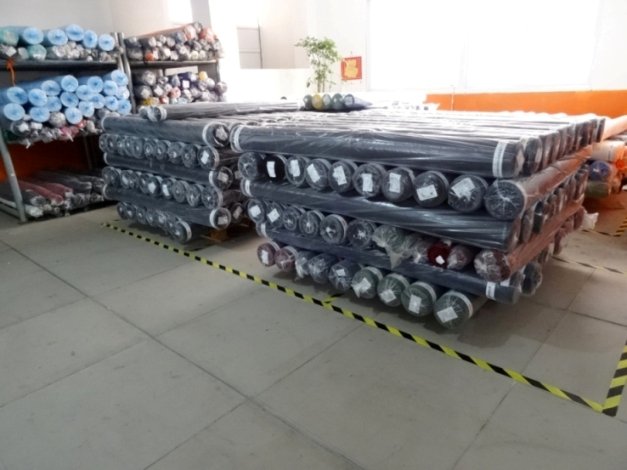
We will go to prepare the umbrella making materials. the main umbrella components are including umbrella frame, umbrella canopy fabric, umbrella handle.
These umbrella components making materials are including below :
umbrella frame material: can be metal, aluminum, or fiberglass
umbrella shaft material: can be metal, aluminum, wooden and fiberglass.
umbrella canopy fabric: the regular use of polyester, pongee or nylon.
umbrella handle material: can be plastic, wooden, aluminum, EVA.
and any umbrella accessories.
If you want Superain to reproduce a specific fabric color, please wait for about 20 days. Apart from a custom frame, requesting a custom umbrella fabric significantly lengthens the manufacturing period.
During peak season, our production time ranges between 30 and 40 days. If you prefer a quicker delivery, you can pick among any of our currently existing umbrella frames and fabrics.
http://mccallsnurseries.com/roseclimbing2.htm Umbrella Material Inspection
Step 2 involves checking the material quality for every part of the umbrella. This guarantees that no umbrella is manufactured with a subpar material.
- http://pedrocabiya.com/tag/desdemona/ Umbrella Fabric
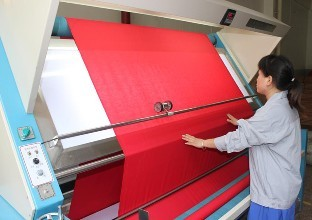
This is the part of the umbrella that will protect you from the sun and rain. Superain Strict running machine inspection will be carried out to ensure that there is no yarn, damage, and other defects.
Moreover, we pay attention to the color of the fabric. We do not merely settle on a similar shade. Superain strives to meet client requirements.
- Umbrella Frame
We check if the frames on hand meet the order qualifications. For one, the surface finish must be impeccable and lacking any signs of corrosion. It must be firm enough to give the user a confident feeling — no one wants a frame that breaks due to strong winds.
Superain also inspects the open/closed button for ample smoothness.
- Umbrella Handle
Assessment of the raw materials for the handle is essential. We determine the model number and color before manufacturing.
Its design affects how comfortable it will be for the customer. The handle must offer a firm grip regardless of the weather. For this, we rely on sample inspections.
Step 3: Large Fabric Cutting
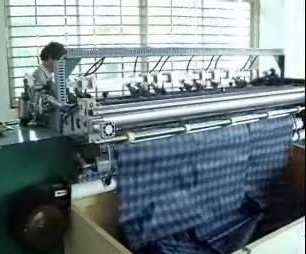
As soon as we’ve done quality tests on all necessary materials, it’s time for primary fabric cutting.
Superain factory uses either machine power or manual labor to cut huge piles of fabric. The goal is to have several pieces of rectangular fabrics.
The number of rectangle-shaped fabrics per umbrella depends on its size. If the size of the umbrella is less than 23 inches, we cut the fabric into three rectangular pieces. For those that exceed 25 inches, we only divide the fabric into two parts.
Step 4: Fabric Edge Locking
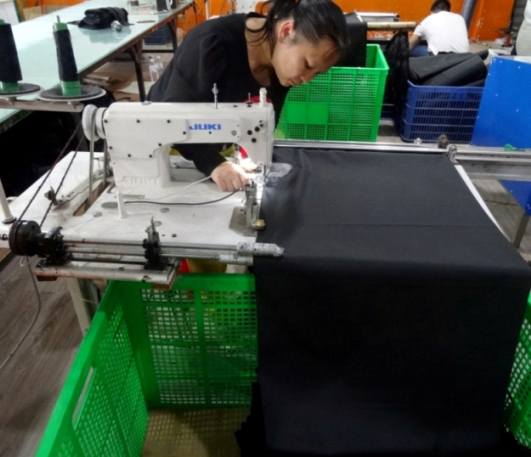
Here, we take the newly cut rectangular pieces of fabric for edge locking. Otherwise known as edge finishing, this process is crucial to the quality of the umbrella.
If we don’t place an edge finish on the fabric, fraying could occur. This is when the edge of the fabric becomes worn and loses its aesthetic appeal.
A sewing machine place the edge finishes on the pieces of fabric. Afterward, the workers inspect the overall quality.
To help give you a better idea, this video shows how an overlock stitch prevents fabrics from fraying:
Step 5: Small Fabric Cutting
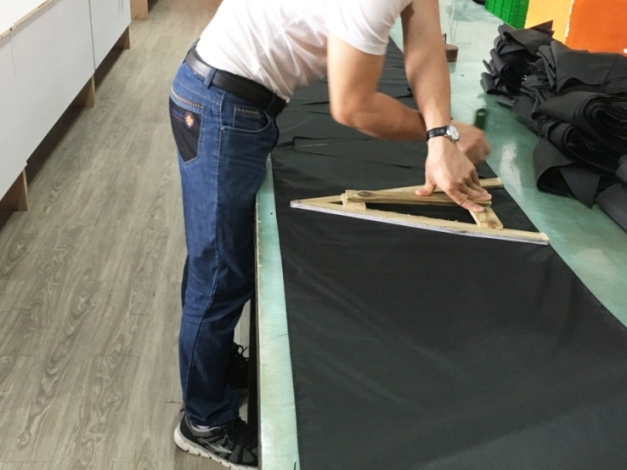
Now that the edges of the cut fabric are secure, we must manually cut them further to form a small triangular panel. This process is known as the small cut or second cut.
You’re probably familiar with how the top portion of an umbrella looks like. Well, putting these triangle-shaped pieces of fabric together will form the canopy.
We’re more than willing to assemble umbrellas with varying numbers of panels. Some only have six triangular panels while other designs call for a whopping 24 panels.
Step 6: Umbrella Fabric Printing
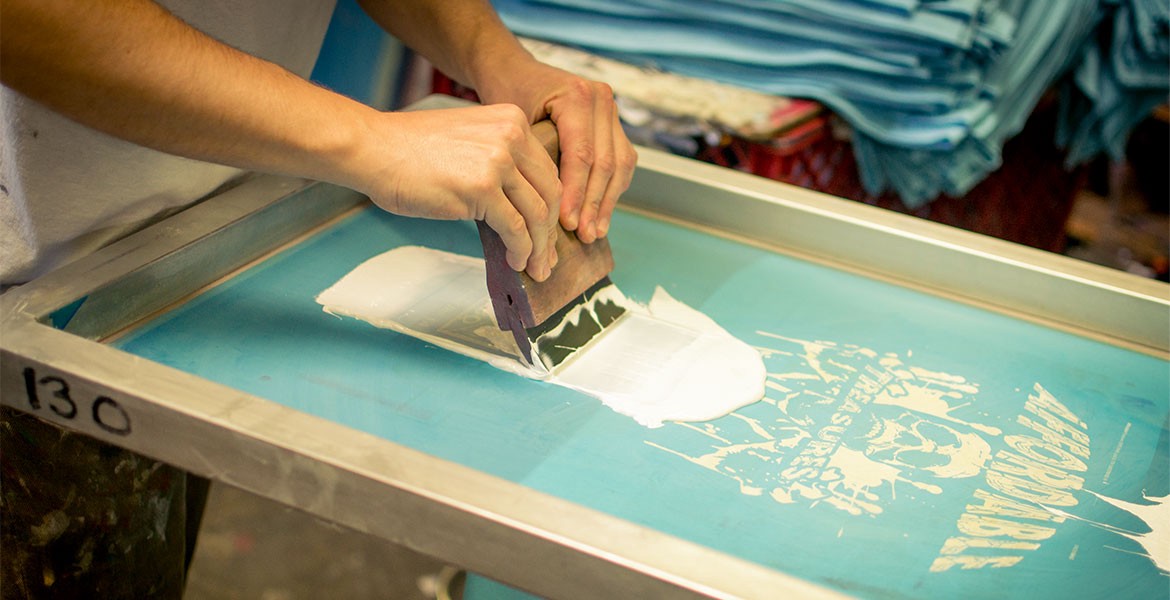
If the small triangle-shaped panels all meet the client’s requirements, we move on to the printing process.
An example of the method we apply is silkscreen printing. This process is quite popular due to its various strengths. In fact, companies around the world have relied on silkscreen printing for more than a century.
For Superain, we acknowledge silkscreen printing for how its impeccable color reproduction. We know our customers will appreciate a print that matches their proposal. Likewise, silkscreen guarantees the durability of custom orders.
Silkscreen printing begins with placing the triangular panels on a table. Afterward, each fabric piece gets a wooden frame. The frame ensures that the graphic print does not go beyond the panel dimensions.
The printing process usually takes between three to five days. However, do expect a longer wait for bulk orders or requests made during a busy season. We’re confident you’ll appreciate the wholesale price when you order many umbrellas.
Step 7: Sewing
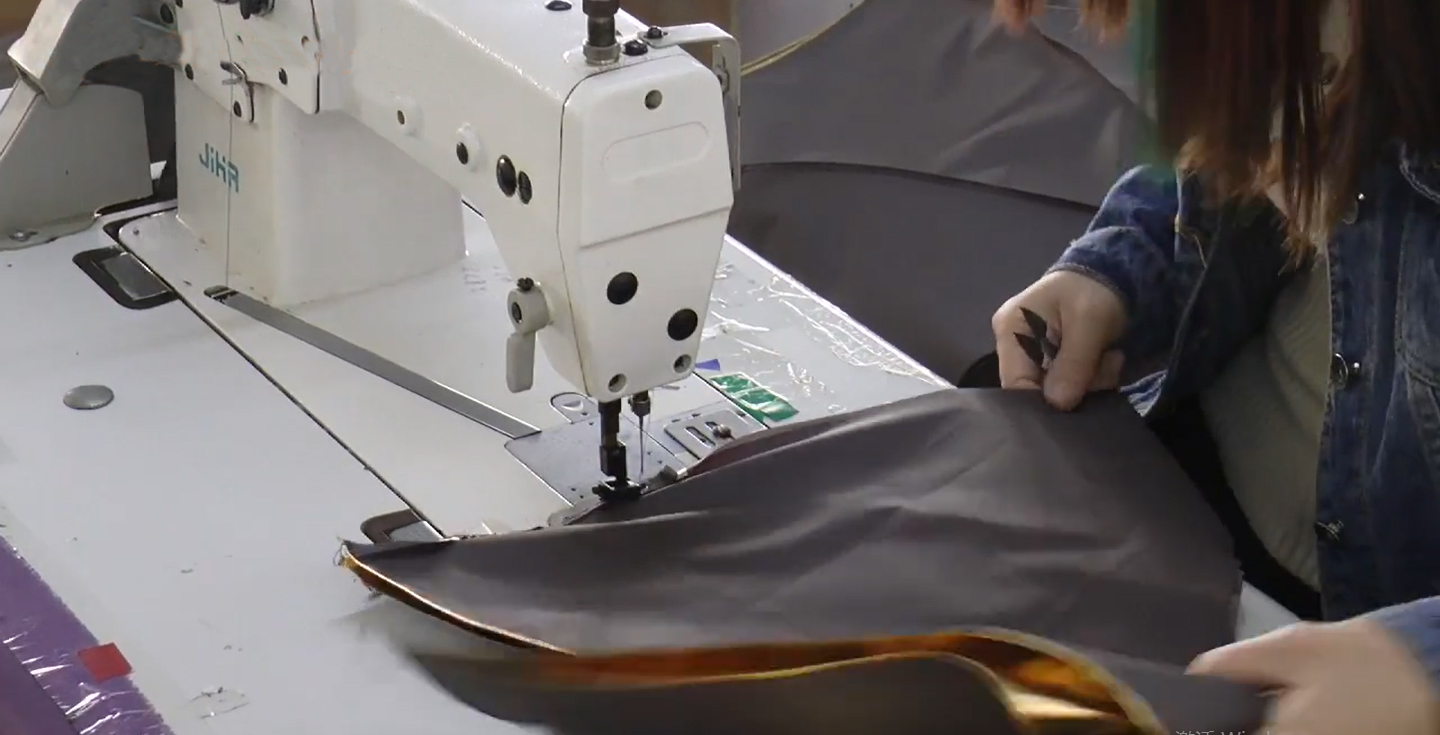
Once the panels themselves have the intended graphic design, they must be combined.
An electric sewing machine places the triangular pieces of fabric together. Furthermore, the umbrella printing is typically placed in front of the sewing panel.
While every step in the manufacturing process is important, sewing the panels together is very crucial. Superain workers must provide enough stitches. Failure to do so ruins the performance of the umbrella — water can seep between the triangular panels whenever rainfall occurs.
The standard for SUPERAIN factory is one inch and ten needles, and some other umbrella factories use one inch six or eight needles.
When the umbrella cover or canopy is complete, we have a special inspector to check it with a lightbox. As its name suggests, a fabric lightbox is made up of various light sources such as artificial daylight, store light, and an ultraviolet light.
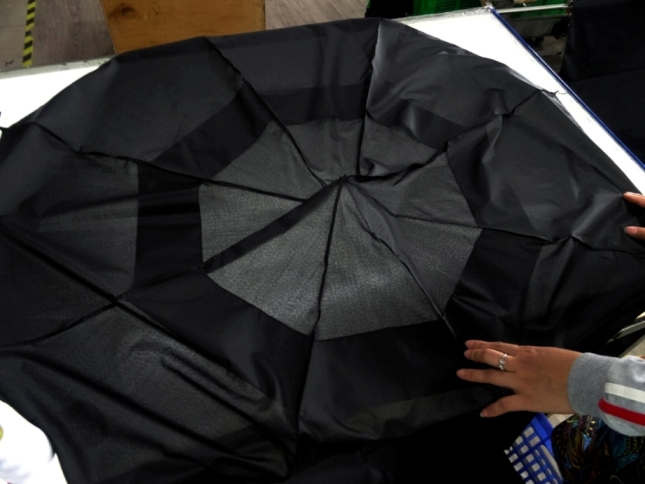
The inspector utilizes the lightbox to check for consistency in color among the triangular panels. Simply put, the box creates different light and shade conditions. This gives the inspector many perspectives from which to check the quality of the umbrella cover.
Step 8: Installing the Tip and Sewing the Strap to the Cover

Constructing the canopy isn’t enough — we need to secure it properly. Otherwise, the umbrella cover on the ribs will remain unstable.
Back then, factories made the umbrella tips by hand. Workers assembled the tips piece by piece. Thus, the slow sewing rate affected the overall manufacturing speed.
Now, modern umbrella factories like ours utilize the latest sewing machines to create the tips. The process involves two steps.
First, we cut out a small circle from the top of the umbrella cover. This allows us to mount the cover on the umbrella frame. Second, we sew the umbrella strap onto the cover.
Step 9: Additional Sewing
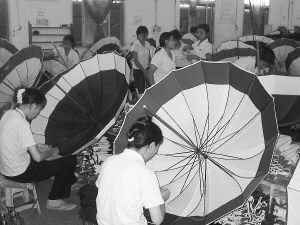
The manufacturing process involves sewing procedures all throughout. This time, we conduct sewing to connect the umbrella cover to the ribs.
The canopy already has its triangular panels, graphic print, and umbrella tips. However, we still need to ensure that it is firmly attached to the ribs. Our workers then use needles to stitch the cover and the ribs together.
Some umbrella manufacturing companies utilize semi-automatic sewing machines. After all, these pieces of equipment are great for sewing straight umbrellas. However, there is nothing wrong with sewing the cover to the rib by hand — especially because this lends it more durability.
Overall, this step varies in duration. The usual period takes between three to 10 days. However, higher order quantities would inevitably lengthen the production time.
Step 10: Installing the Handle and Top Before a Quality Inspection
The manufacturing process is nearly over. There are no more sewing steps necessary. You can easily see what the umbrella will look like in its final form.
However, we still need to attach a couple of important parts — the handle and the top. The umbrella handle completes the bottom section of the Superain product. On a similar note, the top part keeps the shaft and the umbrella cover together while forming the uppermost tip.
Now that we’ve produced all parts and connected them together to form the umbrella, it’s time for a final quality inspection. The switch is once again checked for its smooth texture.
Similarly, Superain looks at the umbrella cover. During the manufacturing process, some parts of the cover might have developed interlocked parts. We want our umbrella covers to be flawless. Any knots or twisted threads are quickly fixed.
Likewise, we evaluate the printing quality to ensure that it satisfies our customers. We determine if the umbrella tops are positioned at the very center. Repairs for the top notch and springs are conducted. Furthermore, the handle and the ribs need to remain sturdy even in strong winds.
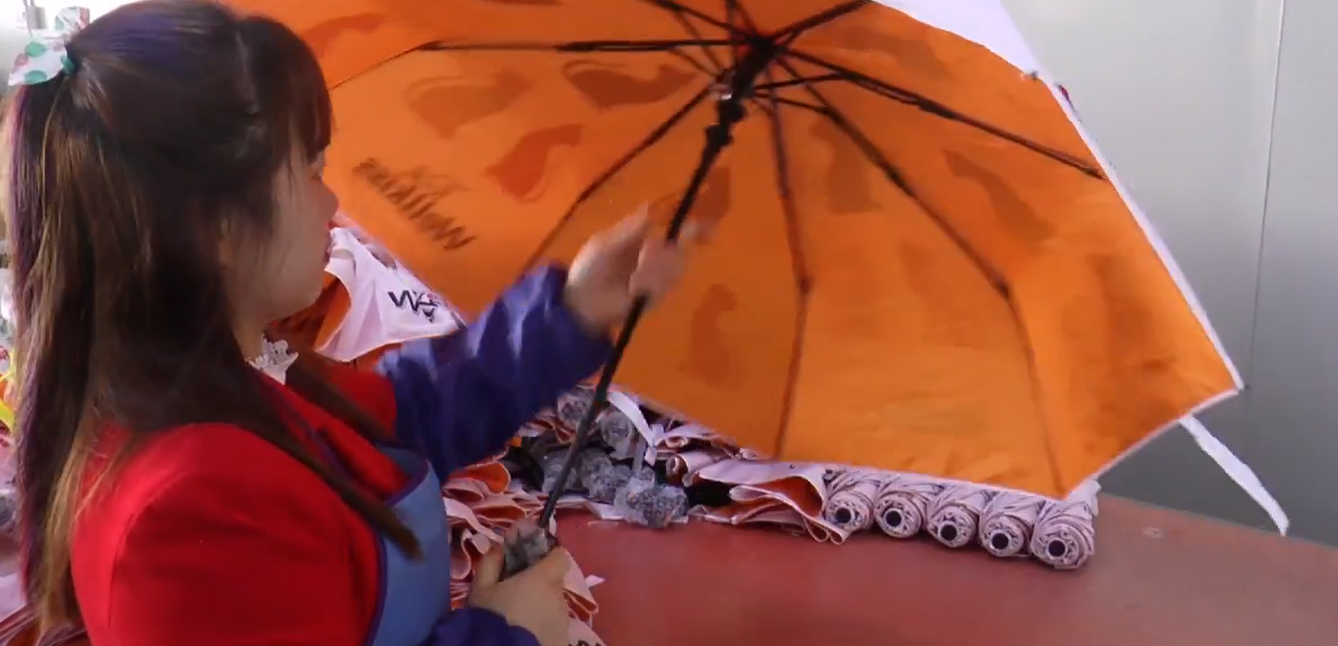
We follow a comprehensive inspection form for our products. Rest assured that we won’t miss any assembling mishaps.
Step 11: Umbrella Packaging
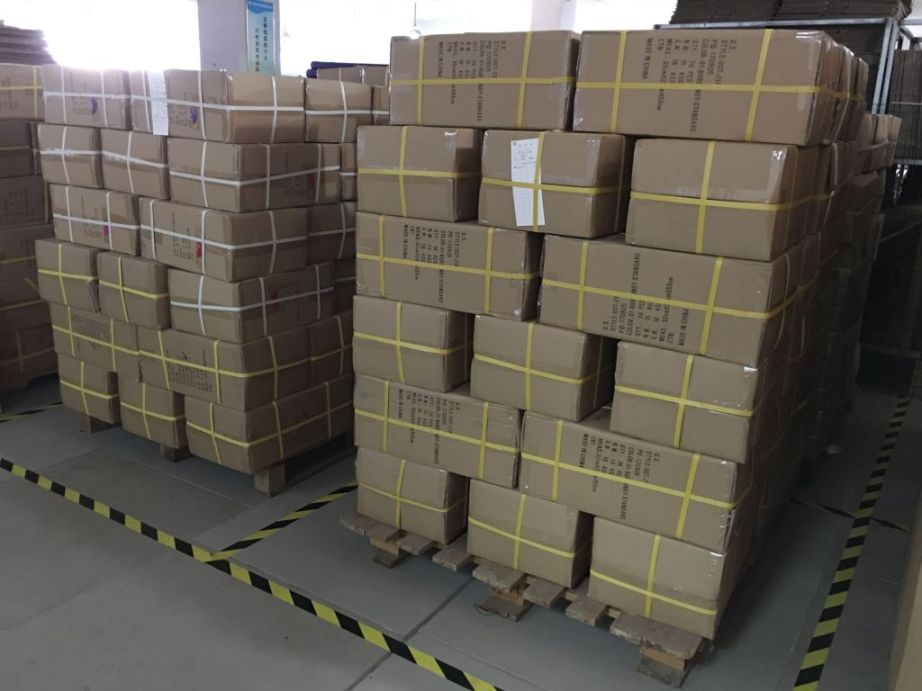
Before we can proceed to actually pack your order, we attach the hang tags first. These are basically those small pieces of cardboard or plastic. It’s similar to what you a shirt in a clothing store.
With a hang tag added to your requested umbrella, you’ll easily know various details. These include the manufacturer’s name, the fabric material, the umbrella model, and basic care instructions.
Afterward, it’s time to bring out the sleeves. This is where you can safely store your umbrella when not in use. The umbrella sleeves protect the fabric from getting scratches or any damage as you travel around.
Now that all your umbrellas are on their respective sleeves, we can put them together in a plastic bag. Our bags are made of polypropylene (PP).

Using PP Bags
Superain uses PP bags because of various factors. For one, PP has great tolerance to high temperatures — it won’t crumble even if gets hot during the delivery and storage period. Second, both water and detergent products don’t damage it. Moreover, it is both flexible yet durable for everyday use.
We put about a dozen umbrellas in an inner box. This is fairly secure on its own, but we don’t want any packaging risks. Once we’ve installed the inner boxes, we put them in a larger carton container.
Our workers carefully weigh all the outer carton boxes. The goal is to have them with the same weight. This assures that each box has the same amount of umbrellas. Once the products are inside, we just have to wait for the delivery date.
Conclusion
We hope that this guide on the umbrella manufacturing process helped you understand how to make an real umbrella.
If you want to custom your own umbrella, feel free to contact us by email:sales@superain.com.
